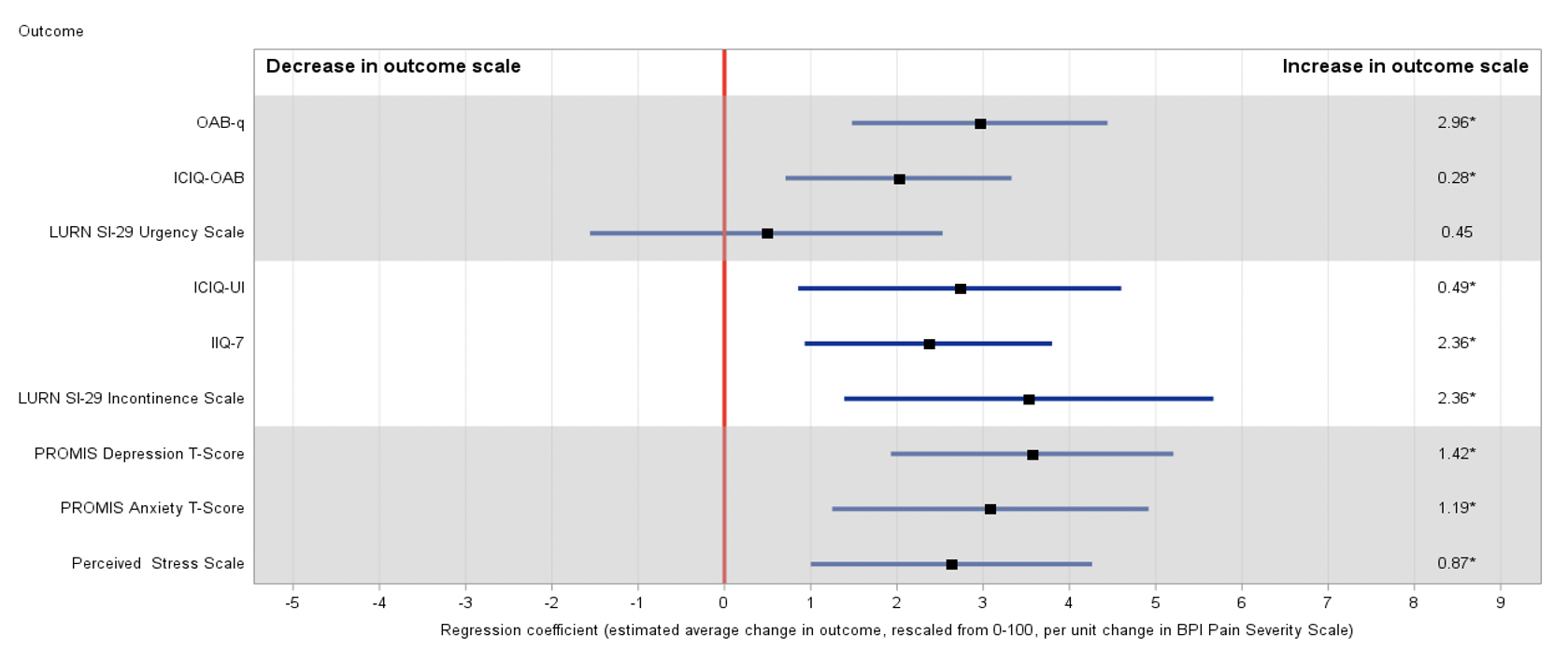Back
Introduction: Some patients with OAB experience pain in addition to urinary urgency (UU) and/or urgency incontinence (UUI). Lai et al (2014) showed that 33% of OAB patients reported pain in the bladder, and hypothesized that OAB with pain resemble OAB-dry without UUI. Reynolds et al (2017) reported even higher rates of concomitant urologic pain in OAB patients, and hypothesized that OAB patients with pain may have central sensitization. The objectives of this study are to further phenotype OAB patients with urologic and non-urologic pain and to compare to those without pain.
Methods: Care-seeking adult women and men with OAB (UU with or without UUI) who enrolled in the Symptoms of Lower Urinary Tract Dysfunction Research Network (LURN) Neuroimaging and Sensory Testing Study completed questionnaires assessing their urologic pain (LURN SI-29 pain subscale), non-urologic pain (Brief Pain Inventory), OAB symptoms, urinary incontinence, psychosocial measures (anxiety, depression, stress levels, trauma), and generalized sensitivity scales (GSS sensory sensitivity, GSS somatic awareness).
Results: Among the 191 OAB participants, 68% reported urologic pain (bladder pain, dysuria), with median pain ratings of 6 out of 100 (interquartile range, IQR 0-25) on the LURN SI-29 pain subscale. 57% reported non-urologic pain, with median pain severity of 1.4 out of 10 (IQR 0-3) on the Brief Pain Inventory. OAB patients with urologic pain had more severe OAB symptoms, psychosocial issues (depression, anxiety, stress) and higher GSS scores than OAB without urologic pain; however, there were no differences in urinary incontinence measures. OAB with non-urologic pain had more severe OAB symptoms, urinary incontinence, psychosocial issues (depression, anxiety, stress) and higher GSS scores than OAB without non-urologic pain (see Figure).
Conclusions: In care seeking patients with LUTS, nearly 2/3 of patients with OAB report mild urologic or non-urologic pain. OAB and urinary incontinence symptoms are more severe in those with pain. Our data supports the concept that the OAB with pain phenotype may have heightened sensitivity and/or awareness to bodily sensation such as urinary urgency and pain. OAB patients reporting concomitant pain appears to represent a separate subgroup of OAB. SOURCE OF
Funding: NIH/NIDDK

Podium Session
Session: PD14: Urodynamics/Lower Urinary Tract Dysfunction/Female Pelvic Medicine: Female Incontinence: Therapy I
PD14-08: PHENOTYPING OAB PATIENTS WITH UROLOGIC OR NON-UROLOGIC PAIN – AND COMPARISON TO OAB PATIENTS WITHOUT PAIN, FINDINGS FROM THE LURN STUDY
Saturday, April 29, 2023
8:10 AM – 8:20 AM CST
Location: S501A

Henry Henry Lai, MD
Professor of Urology and Anesthesiology
Washington University School of Medicine
Podium Presenter(s)
Introduction: Some patients with OAB experience pain in addition to urinary urgency (UU) and/or urgency incontinence (UUI). Lai et al (2014) showed that 33% of OAB patients reported pain in the bladder, and hypothesized that OAB with pain resemble OAB-dry without UUI. Reynolds et al (2017) reported even higher rates of concomitant urologic pain in OAB patients, and hypothesized that OAB patients with pain may have central sensitization. The objectives of this study are to further phenotype OAB patients with urologic and non-urologic pain and to compare to those without pain.
Methods: Care-seeking adult women and men with OAB (UU with or without UUI) who enrolled in the Symptoms of Lower Urinary Tract Dysfunction Research Network (LURN) Neuroimaging and Sensory Testing Study completed questionnaires assessing their urologic pain (LURN SI-29 pain subscale), non-urologic pain (Brief Pain Inventory), OAB symptoms, urinary incontinence, psychosocial measures (anxiety, depression, stress levels, trauma), and generalized sensitivity scales (GSS sensory sensitivity, GSS somatic awareness).
Results: Among the 191 OAB participants, 68% reported urologic pain (bladder pain, dysuria), with median pain ratings of 6 out of 100 (interquartile range, IQR 0-25) on the LURN SI-29 pain subscale. 57% reported non-urologic pain, with median pain severity of 1.4 out of 10 (IQR 0-3) on the Brief Pain Inventory. OAB patients with urologic pain had more severe OAB symptoms, psychosocial issues (depression, anxiety, stress) and higher GSS scores than OAB without urologic pain; however, there were no differences in urinary incontinence measures. OAB with non-urologic pain had more severe OAB symptoms, urinary incontinence, psychosocial issues (depression, anxiety, stress) and higher GSS scores than OAB without non-urologic pain (see Figure).
Conclusions: In care seeking patients with LUTS, nearly 2/3 of patients with OAB report mild urologic or non-urologic pain. OAB and urinary incontinence symptoms are more severe in those with pain. Our data supports the concept that the OAB with pain phenotype may have heightened sensitivity and/or awareness to bodily sensation such as urinary urgency and pain. OAB patients reporting concomitant pain appears to represent a separate subgroup of OAB. SOURCE OF
Funding: NIH/NIDDK

